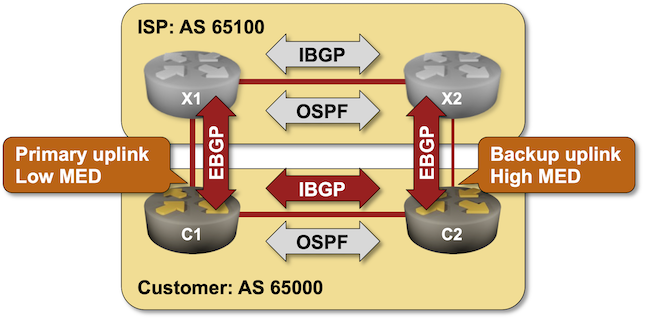D2C220: KubeConversations Part 1 – Platform Engineering
Welcome to a special edition of Day Two Cloud. Host Ned Bellavance traveled to KubeCon Chicago 2023 and spoke to vendors and open source maintainers about what’s going on in the cloud-native ecosystem. This episode features conversations on platform engineering. Part 2 will focus on security. Episode Guests: Cole Morrison, Developer Advocate at HashiCorp LinkedIn... Read more »Introducing hostname and ASN lists to simplify WAF rules creation

If you’re responsible for creating a Web Application Firewall (WAF) rule, you’ll almost certainly need to reference a large list of potential values that each field can have. And having to manually manage and enter all those fields, for numerous WAF rules, would be a guaranteed headache.
That’s why we introduced IP lists. Having a separate list of values that can be referenced, reused, and managed independently of the actual rule makes for a better WAF user experience. You can create a new list, such as $organization_ips, and then use it in a rule like “allow requests where source IP is in $organization_ips”. If you need to add or remove IPs, you do that in the list, without touching each of the rules that reference the list. You can even add a descriptive name to help track its content. It’s easy, clean, and organized.
Which led us, and our customers, to ask the next natural question: why stop at IPs?
Cloudflare’s WAF is highly configurable and allows you to write rules evaluating a set of hostnames, Autonomous System Numbers (ASNs), countries, header values, or values of JSON fields. But to do so, you’ve to input a list of Continue reading
BGP Labs: Using Multi-Exit Discriminator (MED)
In the previous labs we used BGP weights and Local Preference to select the best link out of an autonomous system and thus change the outgoing traffic flow.
Most edge (end-customer) networks face a different problem – they want to influence the incoming traffic flow, and one of the tools they can use is BGP Multi-Exit Discriminator (MED).

BGP Labs: Using Multi-Exit Discriminator (MED)
In the previous labs, we used BGP weights and Local Preference to select the best link out of an autonomous system and thus change the outgoing traffic flow.
Most edge (end-customer) networks face a different problem – they want to influence the incoming traffic flow, and one of the tools they can use is BGP Multi-Exit Discriminator (MED).

White House Unveils National Spectrum Strategy
The plan targets five bands for greater use, calls for a dynamic spectrum-sharing testbed, and incentives for advanced management products.HW015: What Every Wi-Fi Pro Needs To Know About Private LTE
Private LTE and Wi-Fi use a lot of overlapping skills but there are also some key differences that Wi-Fi pros need to be aware of.
The post HW015: What Every Wi-Fi Pro Needs To Know About Private LTE appeared first on Packet Pushers.
HW015: What Every Wi-Fi Pro Needs To Know About Private LTE
Private LTE and Wi-Fi use a lot of overlapping skills but there are also some key differences that Wi-Fi pros need to be aware of. Dr. Avril Salter joins host Keith Parsons to highlight important distinctions between Wi-Fi and private LTE or 5G networks, including spectrum use and application suitability. They also discuss the complexity... Read more »Streaming and longer context lengths for LLMs on Workers AI

Workers AI is our serverless GPU-powered inference platform running on top of Cloudflare’s global network. It provides a growing catalog of off-the-shelf models that run seamlessly with Workers and enable developers to build powerful and scalable AI applications in minutes. We’ve already seen developers doing amazing things with Workers AI, and we can’t wait to see what they do as we continue to expand the platform. To that end, today we’re excited to announce some of our most-requested new features: streaming responses for all Large Language Models (LLMs) on Workers AI, larger context and sequence windows, and a full-precision Llama-2 model variant.
If you’ve used ChatGPT before, then you’re familiar with the benefits of response streaming, where responses flow in token by token. LLMs work internally by generating responses sequentially using a process of repeated inference — the full output of a LLM model is essentially a sequence of hundreds or thousands of individual prediction tasks. For this reason, while it only takes a few milliseconds to generate a single token, generating the full response takes longer, on the order of seconds. The good news is we can start displaying the response as soon as the first tokens are generated, Continue reading
Is Anyone Using netlab on Windows?
Tomas wants to start netlab with PowerShell, but it doesn’t work for him, and I don’t know anyone running netlab directly on Windows (I know people running it in a Ubuntu VM on Windows, but that’s a different story).
In theory, netlab (and Ansible) should work fine with Windows Subsystem for Linux. In practice, there’s often a gap between theory and practice – if you run netlab on Windows (probably using VirtualBox with Vagrant), I’d love to hear from you. Please leave a comment, email me, add a comment to Tomas’ GitHub issue, or fix the documentation and submit a PR. Thank you!
Is Anyone Using netlab on Windows?
Tomas wants to start netlab with PowerShell, but it doesn’t work for him, and I don’t know anyone running netlab directly on Windows (I know people running it in a Ubuntu VM on Windows, but that’s a different story).
In theory, netlab (and Ansible) should work fine with Windows Subsystem for Linux. In practice, there’s often a gap between theory and practice – if you run netlab on Windows (probably using VirtualBox with Vagrant), I’d love to hear from you. Please leave a comment, email me, add a comment to Tomas’ GitHub issue, or fix the documentation and submit a PR. Thank you!